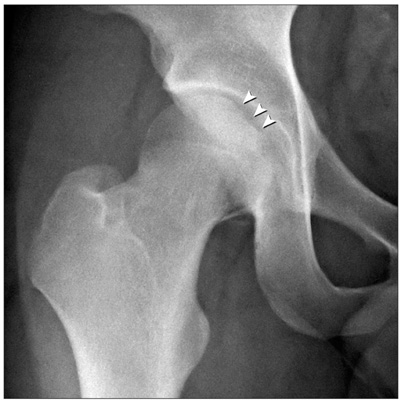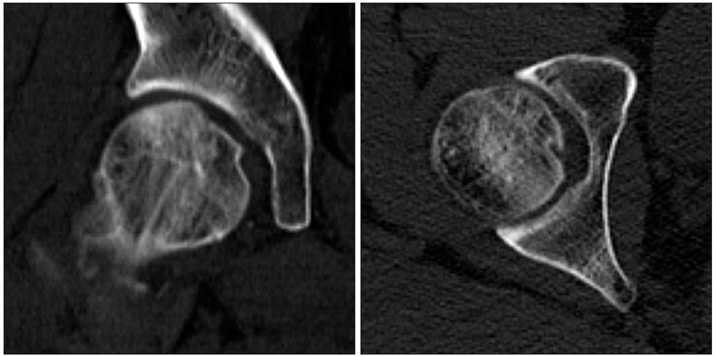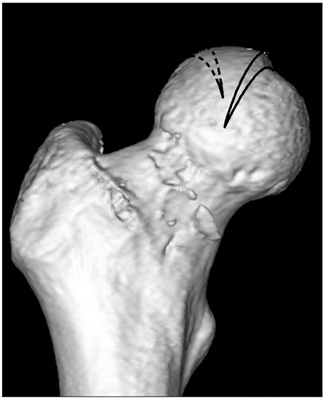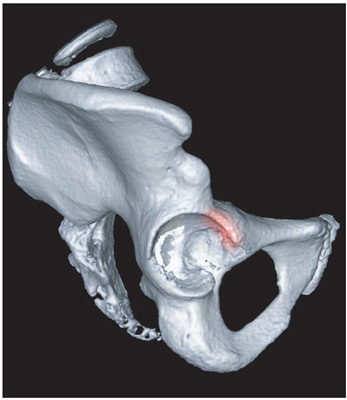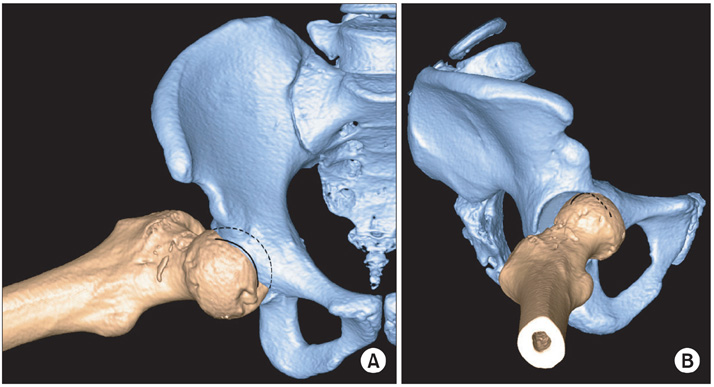Clin Orthop Surg.
2011 Dec;3(4):336-341. 10.4055/cios.2011.3.4.336.
Femoral Head Fracture without Dislocation by Low-Energy Trauma in a Young Adult
- Affiliations
-
- 1Department of Orthopedic Surgery, Seoul National University College of Medicine, Seoul, Korea. oskim@snu.ac.kr
- KMID: 1097173
- DOI: http://doi.org/10.4055/cios.2011.3.4.336
Abstract
- We describe the case of a healthy young man with a femoral head fracture by low-energy trauma that occurred without evidence of hip dislocation. While plain radiographs showed no definite fracture or dislocation, computed tomography (CT) and magnetic resonance imaging (MRI) revealed a femoral head fracture with a wedge-shaped cortical depression at the superomedial aspect of the femoral head. Our patient reported feeling that the right hip had been displaced from its joint for a moment. This probably represented subluxation with spontaneous relocation. The characteristic findings and possible mechanisms of this fracture were postulated on the basis of the sequential 3 dimensional-CT and MRI. The clinical results of conservative treatment were better than those of previously reported indentation fractures.
MeSH Terms
Figure
Cited by 1 articles
-
Traumatic Femoral Head Fracture without Hip Dislocation - A Case Report -
Ji Wan Kim, Hyun-Wook Chung, Taek-Soo Jeon, Hyung-Nam Shim, Tae-Yeon Yoon, Young Chang Kim
Hip Pelvis. 2012;24(3):256-260. doi: 10.5371/hp.2012.24.3.256.
Reference
-
1. Matsuda DK. A rare fracture, an even rarer treatment: the arthroscopic reduction and internal fixation of an isolated femoral head fracture. Arthroscopy. 2009. 25(4):408–412.
Article2. van der Werken C, Blankensteijn JD. Fracture of the femoral head without dislocation: a case report. Acta Orthop Scand. 1987. 58(2):173–174.
Article3. Mody BS, Wainwright AM. Fracture of the femoral head without associated hip dislocation following low-energy trauma: a report of two cases. Arch Orthop Trauma Surg. 1996. 115(5):300–302.
Article4. Houben R, Londers J, Somville J, McKee A. Post-traumatic incongruent hip in a 12-year-old boy. Acta Orthop Belg. 2007. 73(2):255–257.5. Pringle JH, Edwards AH. Traumatic dislocation of the hip joint: an experimental study on the cadaver. Glasgow Med J. 1943. 21:25–40.6. Epstein HC. Traumatic dislocations of the hip. Clin Orthop Relat Res. 1973. (92):116–142.
Article7. Rancan M, Esser MP, Kossmann T. Irreducible traumatic obturator hip dislocation with subcapital indentation fracture of the femoral neck: a case report. J Trauma. 2007. 62(6):E4–E6.
Article8. Stein DA, Polatsch DB, Gidumal R, Rose DJ. Low-energy anterior hip dislocation in a dancer. Am J Orthop (Belle Mead NJ). 2002. 31(10):591–594.9. Ruppert R. Traumatic anterior dislocation of the sportsman's hip. Sportverletz Sportschaden. 2004. 18(1):34–36.10. Trousdale RT. Recurrent anterior hip instability after a simple hip dislocation: a case report. Clin Orthop Relat Res. 2003. (408):189–192.
- Full Text Links
- Actions
-
Cited
- CITED
-
- Close
- Share
- Similar articles
-
- Femoral Head Fracture with Hip Dislocation Treated by Autologous Osteochondral Transfer (Mosaicplasty) - A Case Report -
- An Irreducible Hip Dislocation with Femoral Head Fracture
- Posterior Hip Dislocation with Ipsilateral Fractures of the Femoral Head and Intertrochanter: A Case Report
- Updates on Treatment of Femoral Head Fractures
- Hip Fracture-dislocation with Sciatic Nerve Palsy and Ipsilateral Femoral Shaft Open Fracture: A Case Report

